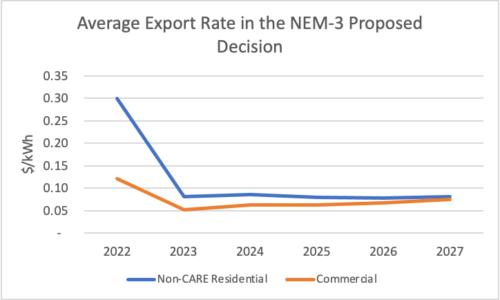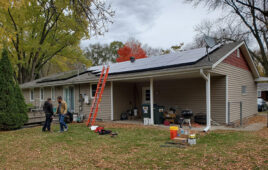With an expected Dec. 15 commission vote looming, the California Solar & Storage Association (CALSSA) is still hoping to convince the California Public Utilities Commission to make more changes to NEM 3.0, the next step in the state’s solar net-metering program. CALSSA is using all tools at its disposal — from public pressure to conversations with commissioners — to push for some final tweaks to the new net-metering regime.
“This is going to hurt no matter what, but right now it’s pretty devastating pain,” said Bernadette Del Chiaro, executive director of CALSSA.
Above all, the group is seeking higher export compensation rates for a more gradual “glide path” than the one laid out in the proposed decision (PD). CALSSA’s original proposal to the CPUC was an eight-year glide path, but the PD features a five-year path with a 75% average decrease of exported energy value from NEM 2.0 in Year 1. CALSSA says that glide path is more of a cliff.

The structure for the new net billing proposal includes base hourly export compensation rates with a different 24-hour profile for each month and for weekends vs. weekdays. Solar customers also receive a small avoided cost adder in PG&E and SCE territory.

An example of a base export compensation rate chart for PG&E customers on weekdays put together by CALSSA. The heat map highlights the lowest and highest export rates for the year. These charts would apply to both residential and commercial solar customers.

The Avoided Cost adders, which will remain constant for a customer for nine years from the interconnection date in the PD. The adders will decrease by 20% annually until they reach zero.
The CPUC has emphasized that a primary goal of NEM 3.0 is to encourage more people to pair solar with storage to dispatch solar to the grid when it needs the power most. But CALSSA believes these changes are not nearly comprehensive enough to support the growth of an entirely new industry.
“Nobody should have to open up this [Avoided Cost Calculator] chart each day and see if they should reprogram their battery. We’re not there yet. This is the whole idea of the [glide path],” Del Chiaro said.
CALSSA is also pushing for more parity for the commercial sector in NEM 3.0, including schools, apartments, farms and other entities. While residential customers in PG&E or SCE territory receive a small avoided cost adder, commercial customers receive no adder in the PD.
“They’re treating commercial pretty roughly,” Del Chiaro said.
The CPUC is accepting comments on the PD until Nov. 30. CALSSA is contributing to those comments, talking to commissioners directly and organizing a day of rallies on Dec. 1. The rallies will take place in cities across the state, from San Francisco to San Diego, from 11 a.m. to 12 p.m. PT that day.
According to the CPUC’s proceeding brochure, an Alternate Proposed Decision can be filed by a commissioner prior to the final vote. In that case, the commissioners consider the PD and the Alternate Proposed Decision at the Voting Meeting. CALSSA will be pushing for an alternate proposal until that day.





Considering the fact PG&E honors me with less than .02 cents for each kWh I export and charges an exorbitant amount for the the little I use at night, it is a wonder the State sides with the company. Installed in August of 2021, I am paying 100% of my solar system do to the fact my Social Security disability benefits are low enough not to pay taxes and therefore I do not qualify for the tax credits that would offset the installation cost.
It would be nice to be seen.
” Installed in August of 2021, I am paying 100% of my solar system do to the fact my Social Security disability benefits are low enough not to pay taxes and therefore I do not qualify for the tax credits that would offset the installation cost.”
Interesting, this is the beginning of a ‘tell’. There are folks out there who (don’t qualify) for the ITC, are on a fixed income and yet they still have a solar PV system installed. This is the nexus of “WE can’t afford to NOT have our own solar PV system installed.” The rest of the U.S. needs to take a good long look at what California is doing and what the (average) retail electricity rates are right now. On average electricity in California is around $0.25/kWh with all of the block tiered electricity rates, TOU rate spiking periods and “emergency” charges of energy bought on the spot market and imported from other States. A white paper written for the CPUC a few years ago, predicts between 2025 and 2030 retail electricity rates in California will be around $0.35/kWh on average.
If you are grandfathered into NEM 2.0 will you solar install switch to NEM 3.0 if you sell your home? If so, the increased home value for solar I stall would be lost.
No, the grandfathering stays with the property.
See below from page 186 & 187. Long story short, the system doesn’t need to be installed to lock customers in NEM2.0. Am I understanding this correctly?
https://docs.cpuc.ca.gov/PublishedDocs/Efile/G000/M498/K526/498526033.PDF
Step 4: No later than 120 days after the adoption of this decision, the Commission will implement the NEM 2.0 tariff sunset marking the end of the Sunset Period, at which time no additional customers will be permitted to take service under the NEM 2.0 tariff. Joint Utilities recommend establishing the eligibility for inclusion in the Sunset Period based on the interconnection application date.481 The Commission adopts this policy. CALSSA recommends defining “interconnection application date” as an application that is free of deficiencies but may not yet have the post-inspection notification from the local building department.482 SEIA/Vote Solar agree with CALSSA’s recommendation because “system completion can be delayed for a host of reasons not in the customer’s control.”483 These assertions are reasonable. Accordingly, the interconnection application date is defined as the submission date of an application that is free of major deficiencies and includes a complete application, a signed contract, a single-line diagram, a complete California Contractors License Board Solar Energy System Disclosure Document, a signed California Solar Consumer Protection Guide, and an oversizing attestation (if applicable). The Sunset Period will protect customers who are in the process of contracting for NEM 2.0 tariff service. As previously stated, customers submitting completed applications prior to or on this date will be considered NEM 2.0 customers.
I read the same thing on the proposed decision and interpreted it the same way. The final decision has slightly different wording:
“Step 4: No later than 120 days after the adoption of this decision, the
Commission will implement a tariff sunset on NEM 2.0, after which time no
additional customers will be permitted to take service under the NEM 2.0 tariff.
Joint Utilities recommend establishing the buffer period based on the
interconnection application date.429 We find this buffer period will protect
customers who are in the process of contracting for NEM 2.0 tariff service.
Customers submitting interconnection applications after this sunset date will
take service and be billed on the NEM 2.0 tariff and then be transitioned to the
successor tariff once it is operationalized. Any delay in Step 3, the processing of
the advice letters in Steps 1 and 2, will result in an equal, day-for-day, extension
of time in Step 4. Customers signing an installation, lease or PPA contract after
this sunset date will take service and be billed on the NEM 2.0 tariff and then be
transitioned to the successor tariff once it is operationalized”
You can see they dropped the wording spelling out that a signed building permit is not required for a completed interconnection agreement. Not sure what this means
The technology is alreadly in the wind, where companies like Enphase Energy and SolarEdge are capable of adding Energy storage to their systems. As energy credits and avoided costs ‘adders’ fall to zero, one can capture more energy every day in their own ESS, time shift and use this to offset TOU spikes during the day and early evening hours of electricity use. Allowing the residential customer to have reliliency during PSPS events, arbitrage of electricity rates and overall grid agnostic operations daily.